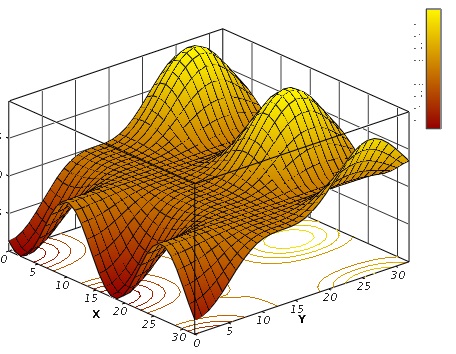Level: Alchemist
Read time: 8 minutes.
Would you have a graph showing the temperatures at which type V crystals melt for different chocolates?
Part two
If you have not read last week’s answer, go ahead and read it. I’ll wait.
Good. You are up to speed? Good. Let us proceed.
One of the big problems is that different ingredients change your tempering temperatures in different ways. The more cocoa butter you have, the higher you will be able to take your chocolate. Similarly, the more sugar you have, the cooler you need to keep your chocolate. Have a look at these graphs.
Basically, the two changes cancel each other out. Which makes sense. If you have more sugar, and the added cocoa butter is constant then you have to reduce the cocoa beans which reduces the overall cocoa butter. But notice too how the data is all over the place. It isn’t really predictive. There is a general trend. That’s all. It’s because, as you know, tempering has a lot going on that affects it.
The method you use be it slab or bowl or machine. How much you are tempering has an effect due to heat loss. And your ambient temperature likewise will have an effect for that same heat loss reason.
Look. I know this isn’t really helping you learn to temper. And it can be kind of discouraging. My point in all this is that graphs are not practical day to day.
But the general trends can be helpful. More cocoa butter gives you a higher temperature. More sugar less so. To combat more sugar, a little more cocoa butter will probably be a good idea. Those are the kind of things I want you to be able to think through.
Alright, one more thing. This last part is about the subtlety of tempering. In short it is another reason that graphs are not practical in day to day use. Recall those graphs above? Notice how although there is a general trend the data’s predictive power really kind of sucked? That is because there is another variable at work here mucking up the works.
It has everything to do with how much Type V seed you have in your working chocolate and at what temperature you are working at. Most people who work with chocolate know the word tempering. They know in general it is a process. That of making Type V crystals so that their chocolate will have a nice snap.
What many don’t realize is that while you are in the middle of tempering, lots of things are going on. From what I can tell the generally understood concept is that you are make or adding Type V seed and as long as you are holding it a the right working temperature, nothing is going on. The Type V is stable and just waiting for you to pour it into molds.
But that isn’t the case. Double negative alert. Nothing never happens.
And I bet you have seen this. You are at the perfect 89 F. You are keeping it right there. You are pouring your chocolate into molds. You go back for the next ladle full…..and the chocolate is thicker. You check your temperature. Yep, still 89 F. Did you get water in it? What’s wrong? It was working perfect, now it isn’t. You rush to finish only to find you last bars bloomed because you had to over work them.
What happened and what could you have done? The answer lies in the fact that (get ready for it) nothing wasn’t happening. i.e. something was happening in your bowl even if you didn’t see it. What was happening was that you set up the perfect conditions (like you want to) for Type V crystals to form. So they formed and your chocolate got thicker.
What could you have done?
As sacrilegious as it sounds, you need at that point to heat up your chocolate and start destroying some of the Type V crystals. There really can be too much of a good thing and thick chocolate while you are tempering is the demonstration of that.
But remember, nothing is never happening. As you heat up your chocolate (say 0.5 F BTW) you start to destroy some Type V. But recall, you also have perfect conditions to form Type V. So even though you getting rid of some, you are also forming some. The key is that those rates are different.
Analogy time. You are building a stack of blocks in the back of a moving van. That is your job. You can’t stop. Soon the stack gets too high and they can’t moved around without them falling apart (i.e. molding up with streaking because the chocolate is thick). So you need to some else to take some blocks off while you keep building (because you can’t do nothing). So Bob (your uncle) starts to unstack blocks on the really tall stacks while you keep adding more on. He is removing, you are adding. As long as he doesn’t work faster than you (you don’t get the temperature too hot) all is fine. There are plenty of stacks for you both to work on.
Now here is the key. When do you put Bob to work? If you put him to work too early (have too warm a temperature) tearing down blocks, while your stacks are small, it might be he would not let you form any at stacks (Type V) at all. If you put him to work too late your stacks are too big and unwieldy (the chocolate is too thick).
This is why tempering temperatures vary too. They are time dependent and also vary depending on how big your stacks are. Your goal is to find the sweet spot where you are building and Bob is tearing down while you have a bunch of stacks that are not too big. Sometimes you have to heat things up to make Bob work faster, sometime you need to cool things down if Bob is out pacing you.
This is why tempering machines (AT THE RIGHT TEMPERATURE) work so well. They are working in that sweet spot. Building and tearing down at just the right pace.
Let’s bring this all together now. You can see now why those temperature points were all over the place and at some points even higher when they should have been lower. It was related to how long the session was and how much Type V was there initially. A temperature that would ruin your temper at the beginning (say 90 f) might well be needed by the end because you have crystalized more Type V and need to reduce amount some so it can remain workable.
Basically maximum or optimum tempering temperature is a moving target and simply cannot be plotted on a 2 dimensional graph. You might get somewhere plotting 3D like this:
But in reality you are probably going to need something with 5 or more variable to do it justice
I don’t think so!
My suggestion is just live with knowing it’s in the high 80’s to low 90’s and go from there. It’s what all those graphs boil down to anyway.
Good luck and happy chocolate making.
The queue is current empty.
Send in your Ask the Alchemist questions to questions@chocolatealchemy.com




